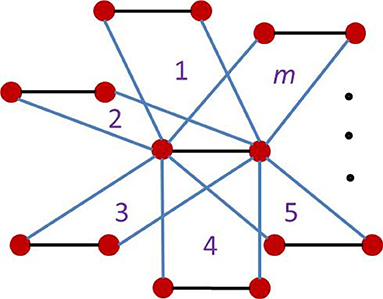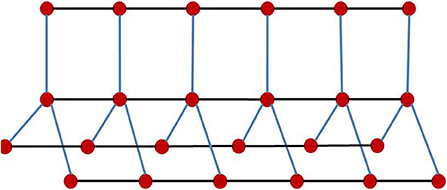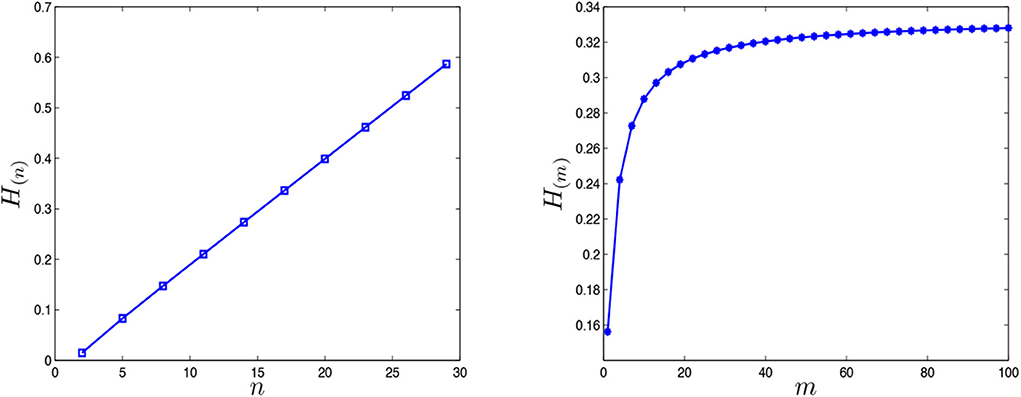- 1School of Information Technology, Zhejiang Yuying College of Vocational Technology, Hangzhou, China
- 2School of Sciences, Hangzhou Dianzi University, Hangzhou, China
In this paper, we study network coherence characterizing the consensus behaviors with additive noise in a family of book graphs. It is shown that the network coherence is determined by the eigenvalues of the Laplacian matrix. Using the topological structures of book graphs, we obtain recursive relationships for the Laplacian matrix and Laplacian eigenvalues and further derive exact expressions of the network coherence. Finally, we illustrate the robustness of network coherence under the graph parameters and show that the parameters have distinct effects on the coherence.
1. Introduction
With the discovery of deterministic small-world [1] and scale-free [2] networks, deterministically growing network models have gained increasing attention because they can provide exact results for topology and dynamics. As a special type of deterministic networks, fractal networks constructed by fractal structures, such as Koch fractals [3], Sierpinski fractals [4], and Vicsek fractals [5], have been widely studied. Presently the main issues that require consideration in fractal networks include random walks [6–9], consensus dynamics [10, 11] and percolation [12]. It is proved that fractal networks are good candidate network models for verifying the results of random graphs.
Calculating the Laplacian spectrum of a network plays an important role in the study of network characteristics. For example, the Kirchhoff index and global mean first-passage time of a network are related to the sum of reciprocals of non-zero eigenvalues [13–15]. The synchronizability [16] of a network refers to the ratio of the second smallest eigenvalue to the largest eigenvalue of the Laplacian matrix. In addition, the effective graph resistance is connected with the Laplacian spectrum [17]. Recently, network coherence [10] was introduced to characterize the extent of consensus of coupled agents under the noisy circumstance and was determined by the Laplacian spectrum in an H2 norm. This concept of the network coherence helps to study the relationship between the Laplacian eigenvalues and network consistency. Great progress has been made for some special networks such as Vicsek fractals [10], tree-like networks [11], Sierpiński graphs [18] and weighted networks [19]. Many works have been devoted to studying the network coherence. Hong et al. studied the role of Laplacian energy on the coherence in a family of tree-like networks with controlled initial states [20]. Patterson and Bamieh investigated the leader-follower coherence and proposed optimal algorithms to select the leaders [21]. Later, Sun et al. proposed a leader centrality to identify more influential spreaders using the optimal coherence [22].
It is known that the topology of a graph dominates the Laplacian eigenvalues [23]. Thus, calculating the Laplacian eigenvalues is a technical challenge and it is theoretical and practical interest to find new ways to calculate them. In this paper, a family of book graphs is chosen as our network models. The topological indices, e.g., randic index, sum connectivity index, geometric-arithmetic index, fourth atom-bond connectivity index, and edge labeling, have been analytically obtained [24, 25]. However, the dynamics of the book graphs remains less understood, in spite of the facts that studying the dynamical processes leads to a better understanding of how the underlying systems work.
The rest of this paper is organized as follows. Book graphs and network coherence are presented in section 2. Section 3 gives detailed calculations of network coherence. Conclusions are given in section 4.
2. Model Presentation and Network Coherence
2.1. Book Graphs
Book graphs Bm are defined as the graph Cartesian product [26], i.e., Bm = Sm+1□P2, where Sm(m ≥ 1) is a star graph and P2 is the path graph on two nodes, see Figure 1. The stacked book graphs Bm,n of order (m, n) are Bm,n = Sm+1□Pn, where Pn(n ≥ 2) is the path graph on n nodes, see Figure 2.
2.2. Network Coherence
The network coherence was introduced to characterize the steady-state variance of the deviation from consensus. The relationship [10] between network coherence and Laplacian eigenvalues was established. The consensus dynamics with the additive noise are given by
where xi(t) is the state of node i and subject to the stochastic noise ηi(t). L is the Laplacian matrix. Ωi is the neighboring node set of node i, and ηi(t) is a delta-correlated Gaussian noise.
Then, the first-order network coherence is defined as the mean, steady-state variance of the deviation from the average of all node values, i.e.,
where var is the expectation of the squared deviation of a random variable from its mean.
Let 0 = λ1 < λ2 ≤ … ≤ λN be the Laplacian eigenvalues. The network coherence is given by
When the network has a smaller variance, it has a higher network coherence, meaning that it is more robust to the noise.
3. Calculations of Network Coherence
In this section, we present the detailed calculations of the sum of reciprocals of the Laplacian eigenvalues and obtain exact expressions of network coherence. According to the structure of Bm,n, its Laplacian matrix reads as
where Lm is the Laplacian matrix of a star graph Sm, that is,
Then, we need to solve the characteristic equation Lm,nx = λx, which is given by
where and the dimension of xi(1 ≤ i ≤ n) is m + 1.
Suppose Lmxi = λjxi, i = 1, 2, …, n, where λj(j = 1, 2, …, m + 1) are the eigenvalues of Lm. Then, Equation (2) becomes
We then rewrite Equation (3) as
where
Further, we have
We rewrite in a recursive form as
From Equation (4), each eigenvalue λj produces to n eigenvalues and Bm,n has n(m + 1) eigenvalues, denoted by . For convenient calculations, we denote the smallest eigenvalues . In the following subsections, we divide λj into two cases: λj ≠ 0 and λj = 0 to obtain the network coherence.
3.1. When λj ≠ 0, j = 2, …, m + 1
Let , where and are two polynomials satisfying , the term gcd is the greatest common divisor. Then, we obtain the following recursive relationships as
where the initial conditions are
From Equation (5), we have
where and are the constant terms of and .
It follows from Equation (6) that
Solving Equation (7) with initial conditions of and yields
where and are the roots of the characteristic equation . The constants and are
Substituting Equation (8) into Equation (6) yields
Next, we need to calculate the first-order terms of and . Using the relationship between and of Equation (5) gives
where the initial values are . Then, we obtain
where
We introduce a new polynomial as
Using the Vieta's formula [26, 27] for , we obtain its constant and first-order terms, denoted by , that is,
3.2. When λj = 0
When λj = 0, has only one root . To obtain all the non-zero roots of , we introduce a new polynomial, i.e.,
Further,
where the initial conditions are . In the same way, we obtain the following coefficients, which are given by
It follows from Equation (9) that
3.3. Exact Solution of Network Coherence for Bm,n
We introduce a polynomial Dn(λ) to obtain the exact solution of the network coherence, i.e.,
According to Equations (10) and (11), the constant and first-order terms of Dn(λ) are
Based on the Vieta's theorem [26, 27], the network coherence reads as
When m = 3, the Laplacian matrix Lm has four eigenvalues, that is, λ1 = 0, λ2 = λ3 = 1, λ4 = 4. Using the above-mentioned calculations, we obtain the analytical expression of network coherence, i.e.,
where , , ,, , , , , , , , , , , , .
3.4. Exact Solution of Network Coherence for Bm
To investigate the effect of the parameters m on the network coherence, we propose another method to obtain the solution regarding the parameters m. When n = 2, the Laplacian matrix is
Then, the characteristic polynomial P(λ) of Lm, 2 is
The roots of this polynomial P(λ) are as follows,
By the definition (1), we finally obtain the network coherence with regard to the parameters m, which is given by
From the expressions (12) and (13), we plot the relationships between network coherence and the parameters m and n, see Figure 3. It shows that the values of network coherence linearly increase with n, while the network coherence will achieve a steady constant state for a large m, i.e., , meaning that the consensus displays worse with increasing values of n. In a word, the number of nodes n in the path graph has more influence than the number of nodes m in the star graph.
4. Conclusions
In this paper, we have studied the consensus problems in noisy book graphs. Using the graph's constructions, we have obtained the recursive relationships for the Laplacian matrix and Laplacian eigenvalues and proposed a method to derive exact expressions of the sum of reciprocals of these eigenvalues. We then have presented exact solutions of network coherence with regard to graph parameters and investigated their effects on the coherence. It is shown that the larger size of star graphs results in better consensus, while the larger size of path graphs leads to worse consensus. The obtained results showed that the structure difference produces distinct performance on the coherence. Our method for the book graphs could be applied to study their random walks and Kirchhoff index.
Data Availability Statement
The raw data supporting the conclusions of this article will be made available by the authors, without undue reservation.
Author Contributions
JC, YL, and WS contributed to the conception and design of the study. JC and YL performed the analytical and numerical results. JC and WS wrote the manuscript. All authors contributed to the manuscript revision, read, and approved the submitted version. All authors contributed to the article and approved the submitted version.
Funding
This work was supported by the Zhejiang Provincial Natural Science Foundation of China (No. LY20F030007).
Conflict of Interest
The authors declare that the research was conducted in the absence of any commercial or financial relationships that could be construed as a potential conflict of interest.
References
1. Comellas F, Ozon J, Peters JG. Deterministic small-world communication networks. Inf Process Lett. (2000) 76:83–90. doi: 10.1016/S0020-0190(00)00118-6
2. Barabási AL, Ravasz E, Vicsek T. Deterministic scale-free networks. Phys A. (2001) 299:559–64. doi: 10.1016/S0378-4371(01)00369-7
3. Dai MF, Li XY, Xi LF. Random walks on non-homogenous weighted Koch networks. Chaos. (2013) 23:033106. doi: 10.1063/1.4810927
4. Wang SJ, Yu ZY, Xi LF. Average geodesic distance of Sierpinski gasket and Sierpinski networks. Fractals. (2017) 25:1750044. doi: 10.1142/S0218348X1750044X
5. Zhang ZZ, Wu B, Zhang HJ, Zhou SG, Guan JH, Wang ZG. Determining global mean-first-passage time of random walks on Vicsek fractals using eigenvalues of Laplacian matrices. Phys Rev E. (2010) 81:031118. doi: 10.1103/PhysRevE.81.031118
6. Condamin S, Bénichou O, Tejedor V, Voituriez R, Klafter J. First-passage times in complex scale-invariant media. Nature. (2007) 450: 77–80. doi: 10.1038/nature06201
7. Wu ZK, Hou BY, Zhang HJ, Jin F. Scaling of average weighted shortest path and average receiving time on weighted expanded Koch networks. Int J Mod Phys B. (2014) 28:1450111. doi: 10.1142/S0217979214501112
8. Peng JH, Agliari E, Zhang ZZ. Exact calculations of first-passage properties on the pseudofractal scale-free web. Chaos. (2015) 25:073118. doi: 10.1063/1.4927085
9. Peng JH, Agliari E. Exact results for the first-passage properties in a class of fractal networks. Chaos. (2019) 29:023105. doi: 10.1063/1.5080481
10. Patterson S, Bamieh B. Consensus and coherence in fractal networks. IEEE Trans Control Netw Syst. (2014) 1:338–48. doi: 10.1109/TCNS.2014.2357552
11. Sun WG, Ding QY, Zhang JY, Chen FY. Coherence in a family of tree networks with an application of Laplacian spectrum. Chaos. (2014) 24:043112. doi: 10.1063/1.4897568
12. Balankin AS, Martinez-Cruz MA, Susarrey-Huerta O, Adame LD. Percolation on infinitely ramified fractal networks. Phys Lett A. (2018) 382:12–9. doi: 10.1016/j.physleta.2017.10.035
13. Klein DJ and Randić M. Resistance distance. J Math Chem. (1993) 13:81–95. doi: 10.1007/BF01164627
14. Bonchev D, Balaban AT, Liu X, Klein DJ. Molecular cyclicity and centricity of polycyclic graphs. I. Cyclicity based on resistance distances or reciprocal distances. Int J Quant Chem. (1994) 50:1–20. doi: 10.1002/qua.560500102
15. Wang XQ, Dai MF, Chen YF, Zong Y, Sun Y, Su WY. Determining entire mean first-passage time for Cayley networks. Int J Mod Phys C. (2018) 29:1850009. doi: 10.1142/S0129183118500092
16. Duan ZS, Chen GR, Huang L. Complex network synchronizability: analysis and control. Phys Rev E. (2007) 76:056103. doi: 10.1103/PhysRevE.76.056103
17. Ellens W, Spieksma FM, Van Mieghem P, Jamakovic A, Kooij RE. Effective graph resistance. Linear Algebra Appl. (2011) 435:2491–506. doi: 10.1016/j.laa.2011.02.024
18. Qi Y, Zhang ZZ, Yi Y, Li H. Consensus in self-similar hierarchical graphs and Sierpiński graphs: Convergence speed, delay robustness, and coherence. IEEE Trans Cybern. (2019) 49:592–603. doi: 10.1109/TCYB.2017.2781714
19. Dai MF, He JJ, Zong Y, Ju TT, Sun Y, Su WY. Coherence analysis of a class of weighted networks. Chaos. (2018) 28:043110. doi: 10.1063/1.4997059
20. Hong MD, Sun WG, Liu SY, Xuan TF. Coherence analysis and Laplacian energy of recursive trees with controlled initial states. Front Inform Technol Elect Eng. (2020) 21:931–8. doi: 10.1631/FITEE.1900133
21. Patterson S, Bamieh B. Leader selection for optimal network coherence. In: Proceedings of the 49th IEEE Conference on Decision and Control. Atlanta, GA (2010). p. 2692–7. doi: 10.1109/CDC.2010.5718151
22. Sun WG, Sun MT, Guan JB, Jia Q. Robustness of coherence in noisy scale-free network and applications to identification of influential spreaders. IEEE Trans Circuits Syst II. (2020) 67:1274–8. doi: 10.1109/TCSII.2019.2929139
23. Grone R, Merris R, Sunder VS. The Laplacian spectrum of a graph. SIAM J Matrix Anal Appl. (1990) 11:218–38. doi: 10.1137/0611016
24. Khalid R, Idrees N, Saif MJ. Topological characterization of book graph and stacked book graph. Comput Mater Con. (2019) 60:41–54. doi: 10.32604/cmc.2019.06554
25. Daoud SN, Elsawy AN. Edge even graceful labelling of some book graphs. J Taibah Univ Sci. (2018) 12: 315–30. doi: 10.1080/16583655.2018.1469292
26. Beineke LW, Wilson RJ, Cameron PJ. Topics in Algebraic Graph Theory. New York, NY: Cambridge University Press (2004).
Keywords: consensus, coherence, book graph, Laplacian spectra, recursive
Citation: Chen J, Li Y and Sun W (2020) Network Coherence in a Family of Book Graphs. Front. Phys. 8:583603. doi: 10.3389/fphy.2020.583603
Received: 15 July 2020; Accepted: 08 September 2020;
Published: 16 October 2020.
Edited by:
Jia-Bao Liu, Anhui Jianzhu University, ChinaReviewed by:
Junhao Peng, Guangzhou University, ChinaZhongjun Ma, Guilin University of Electronic Technology, China
Yu Sun, Jiangsu University, China
Copyright © 2020 Chen, Li and Sun. This is an open-access article distributed under the terms of the Creative Commons Attribution License (CC BY). The use, distribution or reproduction in other forums is permitted, provided the original author(s) and the copyright owner(s) are credited and that the original publication in this journal is cited, in accordance with accepted academic practice. No use, distribution or reproduction is permitted which does not comply with these terms.
*Correspondence: Weigang Sun, cWRzd2dAMTYzLmNvbQ==
 Jing Chen1
Jing Chen1 Weigang Sun
Weigang Sun

